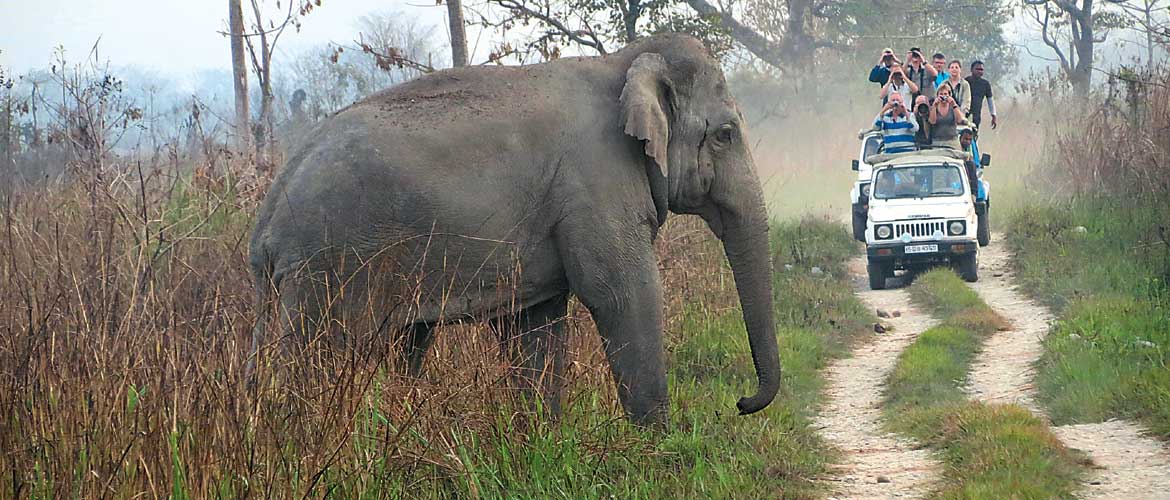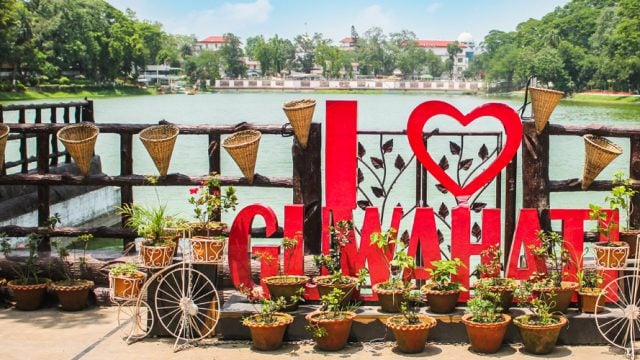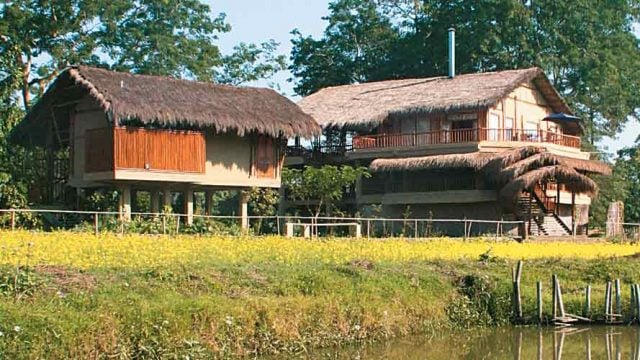Manas National Park is a spectacular jungle and a very unique one. This designated sanctuary
The only unwanted title it has is UNESCO World Heritage Site in Danger, following the Bodoland agitation through the 1980s and much of the 1990s, although thankfully, now matters have improved greatly because of local and government initiatives.
About Manas National Park
The area was once the hunting ground of royals. Formerly known as North Kamrup, it was made a reserve forest in 1928, declared a tiger reserve under Project Tiger in 1973, and eventually made a national park in 1990.
The reserve’s core area is the Manas National Park. It is home to tigers, elephants, wild buffaloes and gaur, apart from sambar and swamp deer. The park mostly comprises eastern Himalayan moist mixed deciduous forest, which is, at places, dense enough to obliterate all sunlight. There is also an alluvial grassland in the eastern part. The park lies in the watershed area of the Manas, Hakua and Beki rivers.
Entry Indians ₹ 50; Foreigners ₹ 500 (half day)/ Indians ₹ 200; Foreigners ₹ 2,000 (full day) Timings 7.30am–2.30pm Jeep hire ₹ 3,000 (4 pax, half day); ₹ 5,000 (4 pax, full day) Photography Indians ₹ 50; Foreigners ₹ 500 Videography Indians ₹ 500; Foreigners ₹ 1,000.
The core area of the tiger reserve spreads over 321sq km of the Manas National Park. The park altogether encompasses over 2,837sq km. In 2002, the Manas Park was designated as the core zone of the Buxa-Manas Elephant Reserve under Project Elephant. The forest, however, extends much further, into neighbouring Bhutan, where it is known as the Royal Manas Park. To the south of the park, NH31 adjoins Barpeta Road, where the Field Director’s office is located. It is from here that you get permits to enter the park in case you plan to stay at Mathanguri, where the Inspection Bungalow is located. Mathanguri is the point through which the River Manas enters India from its source in Bhutan. It is to the north of the park, next to the border with Bhutan.
Tourists pay their entry fee at the Bansbari Range Office, located a kilometre short of the entry gate where an armed ranger joins them. There are no forest department jeeps or guides available for tourists, but private jeeps can be hired from near the Bansbari Range Office or at Barpeta Road. Permits to enter the park are also arranged from here.
Things to See & Do
Visitors to Manas can opt for a jeep safari; an elephant safari should not be missed. This can be coupled with plantation visits and jungle walks. One could also go river rafting on the Manas between Mathanguri and Bansbari.
This expedition of about 20km is organised by the forest department and private operators as well.
Jeep Safaris
You can enter the park either in your own four-wheeler or in a hired one. Silk cotton trees shed their red blossoms on the forest floor, so that the jeep drives over a carpet of petals; a peacock flies up to a branch, silhouetted against the sun rising through the mist. In the distance, across the Manas river, loom the blue-purple hills of neighbouring Bhutan. The vegetation, so different from what is seen in the jungles of the plains, gives the forest a strange, exotic feel. Hornbills swoop across the skies; elephants forage silently at the edge of the trees; insects whirr in the evening. It is classic tiger country, with dense undergrowth thick with moss and vines on which capped langurs caper, open grasses through which hog deer and chital stare, and a river as well as streams that provide watering holes in which enormous wild water buffaloes with metre-long horns wallow.

At night, the jeep lights make the forest seem even more mysterious, with trees rising in odd, twisted shapes from the road, branches leaning out and over and then rising silently above.
Elephant Rides
Whatever you do, don’t pass up the opportunity to take an elephant safari around Mathanguri, deep inside the park, where the government maintains its Inspection Bungalow at a spectacular point overlooking the rushing river and the cloudy Bhutanese hills. These are offered in the grasslands near the park gate and at Mathanguri. The latter is much more enjoyable. Contact the Bansbari Range Office for booking details.
The safaris begin at the crack of dawn, on elephant-back through mossy undergrowth where creepers and stranglers grow like sheets, through groves of oxi trees with great dark leaves, across grassland, along dry stony river beds, up and down steep inclines, with hornbills overhead and sambar all about.
Fee Indians ₹ 500; Foreigners ₹ 1,550 Timings 6.00am; 7.00am
Walks
You can take a walk along a 5-km long jungle trail by the river around Mathanguri, where you will spot a plethora of birds and flowers. Otherwise, your guide may take you along the streams to track animals – it is an absolutely wonderful experience.
Tea Plantations
This area is excellent tea country, and the plantations begin right outside the park. Stop by the Fatemabad Tea Estate adjacent to the Bansbari Lodge for a tour of their factory, or take a walk through their pretty estate.
Village Visit
There are small hamlets adjacent to the sanctuary. You can while away a few hours pleasantly here, walking through the two Bodo villages of Gyatigaon and Raguhbil. There is a cooperative women’s weaving centre here which you can visit. If you’re lucky, you may even happen upon a music and dance session.
Elephant Baths
Children invariably love watching the mahouts bathe the elephants in the river behind the Bansbari Lodge. The setting allows for an excellent photography session.
Where to Stay & Eat
There is limited accommodation in Manas. The government-run Forest Lodge (Cell: 09435124949; Tariff: ₹ 1,200) is 22km inside the park at Mathanguri, by the Manas river. It has six double rooms and a canteen. You have to pay for diesel to help run the generator. However, it is the most picturesque place to stay.

The Bansbari Lodge (Guwahati Tel: 0361-2667871–73, Cell: 092070 42330/ 31; Tariff: ₹ 2,450) is a private hotel right outside the park gate. It has 16 double rooms with hot and cold water and room service. Meals are provided at extra cost (breakfast for ₹ 158 per head, lunch/ dinner ₹ 289 per head). Indian, Chinese and Continental cuisine are served. The lodge organises dance performances in the evenings on request as well as offers transfers from Guwahati.
Birina Tourist Lodge (Tariff: ₹ 2,200–2,500) has a superb location near the Fatehabad Tea Estate, close to the entrance of the Bansbari Range. The rooms are large, clean and airy with a dressing room and attached modern bathrooms. The Lodge arranges jungle safaris, birdwatching treks, bonfire and village tours. They have an open-air theatre for cultural programmes.
Another property close to the park is Florican Jungle Cottage (Tariff: ₹ 2,000), managed by a grass root conservation NGO, based in Bansbari range. The cottages consist of a cluster of six Assam-type thatched cottages with en suite bathroms.
The outfit is totally managed by local villagers trained by Help Tourism. Jungle rides, birdwatching treks, village and cultural experiences are organised. Meals are charged extra. Bookings for both the properties can be made through Help Tourism (Kolkata Tel: 033-24550917, 24549682/ 719, Cell: 09733000442/ 43; helptourism.com). Packages on full board and Jungle Plan are also available here.
Musa Jungle Retreat (Cell: 08761950655, 08811882266, 08811882277; Tariff: ₹ 3,500–9,000) is a new property in Bansbari. This too has a great location, near the park and the tea gardens, with clean, comfortable rooms and good food. The resort arranges jeep safari, river rafting as well as nature walks to the Manas National Park.
On the eastern edge of the national park in Kokilabari, lies the Eco Camp Cottages (Cell: 09864034614, 09435875539; Tariff: ₹ 2,000) managed by the Manas Maozigendri Ecotourism Society. They organise river rafting and jungle safaris for guests.

The Elephant Queen
All of 4’10, wearing a mekhla with sneakers, a bindi and gold earrings, she looks more like a bespectacled school-teacher than a mahout, but Parvati Barua also exudes the kind of steely calm that you’d expect from someone given to climbing into jeans and taking off into the jungle for weeks on end to catch and tame wild elephants. She’s been called the ‘Queen of the elephants’ by the BBC; she’s the lifetime ‘Honorary Chief Elephant Warden of Assam’. At almost 50 years of age, she’s still the only female mahout in India, probably in Asia, and possibly in the world. She is also the recipient of several awards for her work in wildlife protection and is the leading authority on anything related to pachyderms.
Barua comes from an aristocratic family in Gauripur, about 150km from Barpeta, and is a seventh-generation animal-tamer. Her upbringing was, as she says, from “a time of lamps, not lights, and radio, not television”. They had 100 elephants at home. Jungles and animals hold no fear for her – “animals always follow the law” – but she says she is terrified of cities. Since the banning of elephant lassoing in the 1980s, she has been working with the government to train other mahouts in the guru-shishya tradition, and to run refresher courses for the Forest Department’s mahouts.
Her own elephant, Lakhimala, has been with her since 1976 when she was caught at the Buxar Tiger Reserve. Side by side, the elephant reduces Barua to the tiny frail creature that she is; and yet, it’s clear that Barua is the one in control.
Getting There
Air Nearest airport: LGBI Airport at Guwahati (180km/ 4hrs). Taxis cost approx ₹ 5,000
Rail Nearest railhead: Barpeta Road (50km/ 1.5hrs) is linked to Guwahati, Kolkata and Delhi. Taxis charge ₹ 1,500.
Road From Guwahati, take NH31 to Shimlaguri via Nalbari and Howli; link road to Barpeta Road. Drive a jeep or Sumo Bus Several buses ply from Guwahati up to Barpeta Road. Shared Sumos are also available from Guwahati
Fast Facts
When to go November–April. Park closed from May – October
Tourist/ Wildlife offices
Tourist Information Office
Tourist Lodge
Barpeta Road
Tel: 03666-260300
assamtourism.gov.in
Field Director
Manas National Park
Barpeta Road
Tel: 261413
STD code 03666
State Assam
Location On the India-Bhutan border, on the north bank of the River Brahmaputra, northwest of Guwahati
Distance 146km NW of Guwahati
Route from Guwahati NH31 to Barpeta Road; take Barpeta Road upto Bansbari
Dipankar Ghose
East Zone
Manas National Park





